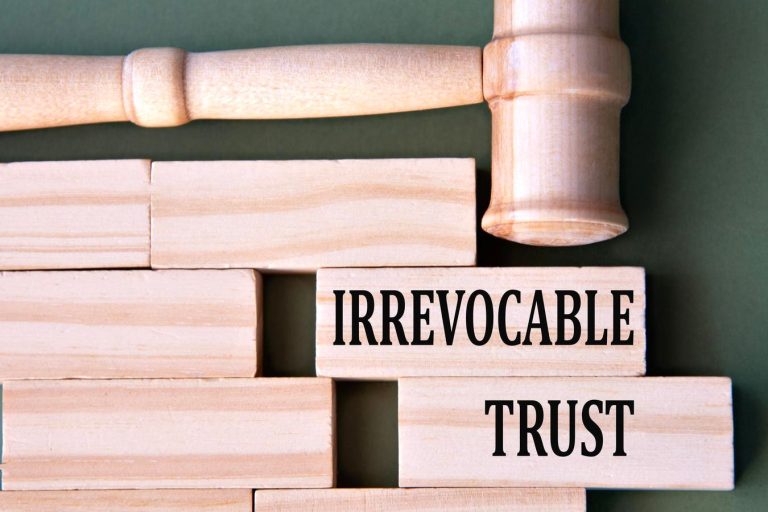Introduction
Many taxpayers created irrevocable trusts and transferred significant assets to them to hopefully save estate tax. Others were named as beneficiaries of trusts that others may have created. Following recent tax law changes does the existing trust plan really work? Assets in most irrevocable trusts won’t receive a basis step up on your death, leaving the specter of substantial capital gains costs. “Basis step-up” is when on death the tax basis, which is used to calculate gain or loss on sale in each asset, is marked to market. So that, for example, if you purchased a stock for $10 and on your death it’s worth $1,000, the tax basis (what you paid for the assets subject to various post-purchase adjustments) is increased to $1,000 and there will be no gain to your heirs if they sell the asset following death.
The new $15 million inflation-adjusted permanent exemption eliminates estate tax worries for most taxpayers (perhaps under 1,500 decedents a year!). That means that your irrevocable trusts may provide no estate tax savings, but they may prevent valuable income tax basis step up. That’s not the tax deal you (or whoever created the irrevocable trust) bargained for. Irrevocable trusts are very common. There are approximately 2.7 million irrevocable trusts in existence. Many of these, including any irrevocable trusts you have, should be evaluated to determine whether and how they might be changed or even terminated to get assets back in your estate for basis step-up purposes. If the trust can be terminated and distribute assets to a beneficiary, those assets may be included in that beneficiary’s estate and qualify for a basis step up.
But not so fast Quick Draw McGraw. There are lots of considerations before you pull the trust termination trigger (and you may decide not to once you’ve really evaluated the situation).
Circumstances to Evaluate and Weigh Before Terminating a Trust
Before terminating an irrevocable trust, or taking other actions to endeavor to obtain a basis step-up for trust assets, consider any relevant factors that may influence the decision. These are broad and go well beyond just income tax considerations. Consider all the possible ramifications of any action you might take for an existing irrevocable trust.
- Appreciation in the trust currently. A critical initial question is how much appreciation is involved with the assets currently held in the irrevocable trust. Is it enough to warrant the analysis discussed below?
- What potential income tax cost might the trust assets realistically face? What is the potential income tax cost of a future sale of those assets on a present value basis. For example, the trust may hold an interest in a family business that is intended to be passed on to many future generations. In that case, the present value of an income tax cost of a sale that may never happen, or may only happen generations from now, may be very low or zero. There are also options for succession or exiting a family business that may minimize potential income tax costs such as using, depending on the facts, a charitable remainder trust to offset capital gains on the sale (assuming that the trust names a CRT as a beneficiary or has a mechanism to add a CRT as a beneficiary), the exclusion permitted under Code Section 1202 for qualified small business stock, the family business equity may be exchanged for the acquiror’s stock on a tax free basis, and so forth. For real estate might a Code Section 1031 like kind exchange that avoids current income tax be viable? It would not be prudent to undertake terminating or modifying an irrevocable trust without understanding whether or not the potential income tax costs would justify it. The decision process in some cases may be more nuanced then many people will initially realize.
- Appreciation that may be in the trust in the future. This is really at the heart of the question. Regardless of what assets and appreciation may be inside the trust now, what is anticipated for the future? Might current assets be sold or traded for other assets in the future? For example, growth stocks may have been held in a particular irrevocable trust for many years and have appreciation but the primary beneficiary, perhaps a surviving spouse, may now be retired and need to tap those assets. That may result in a planned liquidation of assets in the trust over her remaining life expectancy. If that is the case the trust itself is a wasting asset, analogous to a retirement plan, and the appreciation may not be anticipated to be present for the long term. If so, there may be no advantage to terminating the trust to include the assets in her estate as that might only obtain a basis step up on her death if she dies prematurely.
- Tax law changes are a common occurrence. Under current tax law there’s a $15 million permanent estate tax exemption. However, in the future there may be a shift in power in Washington and a Democratic Congress and White House may enact harsh and restrictive estate tax law changes including a much lower exemption. Carefully evaluate what happens if you terminate a trust to put assets back in a beneficiary’s estate only to find that a future tax law change lowers the exemption and now those assets are subject to a substantial estate tax. Remember that the estate tax rate is 40% which is much higher than the capital gains tax. While the current high exemptions make the estate tax academic for most, that may not be the case in the future.
- Where will beneficiaries receiving assets live? A similar scenario could arise if the beneficiary moves. For example, the beneficiary may live in a state with no estate tax and move to a state with a state estate tax that is decoupled from the federal system and a low estate tax exemption. That might result in the beneficiaries might be subjected to a state estate tax. Depending on the state, and the estate tax rules or inheritance tax inheritance tax rules at the time of the beneficiary’s death, much of the intended savings on capital gains could be erased or even exceeded by state estate taxes.
- What is the beneficiaries’ risks of lawsuits, divorce or claims? This may be the biggest threat to any plan to terminate an irrevocable trust (or distribute assets) to try to achieve a basis step up by having assets included in the estate of the beneficiary. This is the most litigious society in history, and nothing that occurs in Washington is unlikely to change that. We still have supposedly an approximately 50% divorce rate. Incidences of elder financial abuse are growing exponentially. If you take assets out of the protective envelope of an irrevocable trust and put them in a beneficiary’s name for a basis step up, the threats to those assets can easily exceed the capital gains cost you’re trying to save. How can you even assess or measure these risks? Because somebody is older and retired may mean they no longer face malpractice or other claims from their business or professional practice (but consider how long the statute of limitations on suits may really be). But as a retired senior they may now face risks of elder abuse or Medicaid costs that could be devastating.
- State laws may be relevant. Assume a trust was created in one state and is governed by the laws of that state but the beneficiary, such as the surviving spouse, has moved to another state. If you distribute assets out of the trust new state law may apply. This could be relevant to the ability of a new spouse of that beneficiary to reach those assets. So, carefully evaluate the legal implications of any transfer of assets out of a trust, or the termination of that trust.
- The wild card of family dynamics has to be considered. Family, however you define that to be, can be incredibly dysfunctional and combative. If assets are in a trust they should be distributed based on the terms of that trust. If assets are distributed out of the trust to a named beneficiary for purposes of obtaining a basis step up how will those assets ultimately be distributed? Certainly, the recipient beneficiary’s will and revocable trust may govern distribution of assets but those documents can be changed and undermine the intended dispositive plan. How can that risk be assessed or controlled? So, for example, the dispositive provisions in a revocable trust could require the consent of a non-adverse party, such as the family advisor, before the provisions of the revocable trust are changed or the revocable trust is revoked. But will everyone involved take those extra steps? What if a family member, once they become aware that the assets are no longer in the protective structure of an irrevocable trust, tries to influence an elderly or infirm beneficiary that received those assets to make gifts to them regardless of what dispositive provisions are in the will and the revocable trust? Might your actions to get a basis step up just be inviting greater potential for family fighting and potential lawsuits? Is that jumping out of the trust frying pan into the family lawsuit fire?
- The adjustment to tax basis on death is often called a “basis step-up” but that is not really correct. It’s really a basis adjustment. The law provides that the cost basis of most assets the decedent owned at death is adjusted to the fair market value (“FMV”) of those assets on the date of death. That adjustment is like the proverbial two-edged sword. If the value of assets declines, the tax basis is reduced, not increased. That could be a lousy tax result. If the trust assets are volatile, e.g., crypto, small cap stocks, etc. what if the person the assets are distributed to dies when the market is down, any actions to move assets out of the trust will have a lousy tax result. Example: A trust owns stock purchased at $500/share that is not valued at $1,000/share. You pull the assets out of the trust and put them in the beneficiary’s estate. The stock markets tank due to recession and the price of that stock declines to $200/share. $200/share becomes the tax basis of the stock. That is a step-down in tax basis not a step up. After death the children as heirs continue to hold the stock and it appreciates back to $500/share and they sell. Had the stock remained in the trust it would have retained its $500/share cost basis. But now, because of the action pulling the stock out of the trust the basis is reduced and there will be a $300/share capital gain that was avoidable. That is not a winner.
Approaches To Address Lack Of Basis Step-Up
Once you have identified and evaluated the potentially relevant circumstances, consider ways that you might increase the basis of assets held in an irrevocable trust. As the old adage goes: “There’s more than one way to skin a cat.” These may include:
- Modifying asset location decisions. Asset allocation refers to how your investment assets are divided between different asset classes. Asset location refers to which buckets those different assets are placed in. So, for example, you may hold certain assets in a Roth IRA, others in a regular IRA, others in in irrevocable grantor trust, and yet different types of assets in an irrevocable non-grantor trust. Which assets, even assuming a constant asset allocation overall, are located in which buckets can have a substantial impact on whether or not there is a benefit to modifying, terminating, or distributing assets from an existing crossed. For example, when the estate tax exemption was only $1 million it may have been advisable to hold growth assets only in an irrevocable Credit Shelter Trust formed on the death of the first spouse. In that way those assets would grow for the long term outside of the estate of the surviving spouse. But now, with a $15 million permanent exemption there may be no concern about growing assets outside of the estate. So, in the current environment if a Credit Shelter Trust exists it may suffice to solve the no basis step up issue by holding non-growth assets like bonds, or actively traded securities, in that irrevocable trust bucket. This approach is simple, may not involve any legal fees or additional documents, retains the protective structure of the irrevocable trust, etc.
- If the particular trust involved is a grantor trust (a Credit Shelter Trust would not qualify) the highly appreciated assets in the trust might be swapped for other assets back into the settlor’s estate. Those assets may then achieve the desired basis step up. While cash is often used in such swaps, that is not the only answer. What if the settlor holds interests in a family business that is intended to be held for many future generations. For example, if the trust assets are comprised of appreciated marketable securities, but the family holds a family business that will be held long term, the assets in the trust can be swapped for the family business interests of equivalent value that the settler of the trust holds. If the trust instrument doesn’t include a right for the settler to swap or substitute assets, but it is assuredly characterized as a grantor trust for income tax purposes, the trust could sell the stock to the settlor for the family business interests the settlor owns. No gain will be triggered on that transaction since transactions between the grantor and their grantor trust are disregarded for income tax purposes. If the settlor does not hold the asset that is desired to shift into the grantor trust but rather a spouse owns it, the spouse can make a gift to the settlor who can then make the transfer. Obviously, reasonable time should be allowed to pass (and other steps be taken) before the swap or sale to avoid the implications of the step transaction doctrine. That could recharacterize the transfer as being from the spouse rather than the settlor. If the target asset that is desired to be in the trust is actually held by another family member it may be possible for that family member to simply make a gift to the grantor of the trust to effectuate the swap. With a $15 million permanent estate, gift and GST, tax exemption the other family member may not be concerned about using some of their gift and GST exemption on such a transfer. So, when evaluating termination or other options whether or not the appreciation that may be of concern inside the trust can be readily shifted.
- Distributing highly appreciated assets out of the trust can put them into a beneficiary’s estate for step up purposes. Many trusts permit principal invasion, meaning the right of the trustee to make discretionary principal distributions to a beneficiary. You need to carefully review the provisions and the trust. If you’re both the beneficiary and the trustee your rights to make distributions to yourself may be limited by what is called an ascertainable standard (health education maintenance and support, or “HEMS”), so that the trust assets are not included in your estate. If that is the case, many trusts permit the ability to appoint an independent co-trustee and may permit that trustee to make discretionary distributions. So, if the trust instrument permits principal distributions or actions can be taken to obtain that flexibility, obtaining a basis step up on highly appreciated assets inside the trust may be no more than merely distributing that highly appreciated asset to a beneficiary. This approach, depending on the circumstances may leave the trust intact with all of its protections and other benefits while just getting the most highly appreciated asset into an ownership where it can benefit from a base of step up. Be certain to review the income tax consequences with your CPA before making such a distribution.
- Changing the trustee. If the goal is to have assets included in the estate of a beneficiary it may be possible to take a simple action to accomplish that. Let’s say that you created an irrevocable trust in one of the states that permits self-settled domestic asset protection trust (“DAPT”). A DAPT is an irrevocable trust you create but are a beneficiary of. Properly done that may remove the assets from your estate. You live in a state that does not permit DAPTs. If the trust protector of such a trust can replace the existing institutional or corporate trustee in a trust friendly jurisdiction (one that permits DAPTs) with you who lives in a state without enabling legislation that may alone cause estate inclusion. That could require little more than an action by a trust protector it may achieve the result you’re trying to obtain. Be mindful that this may undermine any asset protection the trust would afford, and cause all assets in the trust to be pulled into your estate, not only the appreciated ones.
- Decanting might effectuate the desired change or set up the trust so that the desired change can be made after the decanting. Decanting is a process which may be permitted under state law and/or the trust instrument to merge the existing trust into a new trust. The decanting process generally cannot change who the beneficiaries are but can modify administrative provisions that could facilitate the desired objectives. For example, powers of appointment may be able to be added so long as not violative of the intent of the existing trust. Trustee powers may be expanded or clarified. Trust situs and governing law may be changed and new state law may provide more flexibility (in fact the state to which the new trust will be moved could be selected because of more flexible laws). Distribution standards may be modernized permitting more flexibility.
- Exercising powers of appointment may achieve your goal. It is very common in many irrevocable trusts to grant certain persons powers of appointment. A power of appointment is a right to direct where trust assets will pass. In some instances, those powers are limited to only being able to be exercised following death of a name party. In other instances, powers of appointment may be permitted during lifetime. If a power of appointment is permitted during lifetime you may be able to have the power holder exercise that power in a manner that achieves the estate planning goal of a basis step up. If the powers of appointment in the trust are insufficient to accomplish your intended goal it may be feasible to decant the trust into a new trust that contains broader powers of appointment that can then be exercised.
- Trust protector action may effectuate change. A trust protector is a person designated in a document, such as an irrevocable trust, that is granted powers specified in the document. State law may provide certain powers. A common power given to a trust protector is to change the law governing the trust and the situs or location where the trust is administered. This, similar to the decanting explained above, can permit the trust to take advantage of the laws of a state that are more favorable to what is desired.
- Other powerholder provisions may be in the existing trust. Depending on the design of the particular trust, there may be other persons, who could be identified by various names, including “trust protector,” or even just “powerholder,” who might be able to effectuate the change that you have. For example, as Special Power of Appointment Trust (“SPAT”) provides a named person the power to direct the trustee to pay assets to the settlor of the trust. That may resolve the issue of basis inclusion by simply appointing those assets to the person desired.
- Non-judicial modification agreement (“NJMA“) may be used to modify the trust. This must be done under state law so that how much can be changed will depend on the latitude provided under state law. State law may permit broader change if the settlor who created the trust is alive and agrees to the changes. Typically, all beneficiaries and trustees must consent to the modification or at least non-object. In some circumstances, almost any change desired can be made. This can be done without court approval.
Consider Liability Risks of Modifying or Terminating A Trust
Trustees engaging in any of the above techniques should evaluate the potential implications and what if any liability exposure the proposed steps may trigger. Consider the following example:
Father died and his estate passed to a Credit Shelter Trust to benefit his surviving wife and on her death the children. He named his brother as trustee and gave him broad authority to distribute any principal to his wife/beneficiary in the trustee’s sole discretion. The assets in the trust are highly appreciated so the brother distributes them to the wife as permitted under the trust. The assets will be included in her estate and be subject to a basis adjustment (hopefully a step up) on her death. Consider the view of the beneficiaries if assets in an old Credit Shelter Trust are distributed to their surviving parent as a beneficiary to gain a step up in tax basis on her death. If shortly after the distribution the surviving widow remarries and bequeaths the assets to her new husband, how will the children feel? They will have achieved the desired step up in income tax basis but lost their inheritance.
What about the liability exposure of advisers who may have cavalierly recommended the plan. Will having the children sign off approving the plan suffice to insulate the trustee and advisers from liability? Maybe. But if the attorney for the wife handled the planning and transaction, who represented the beneficiaries? If they did not have legal counsel might they argue in their suit against the trustee and advisers that they were misled? Caution is in order.
Make a Trust Action Plan
Consider having the advisors to the family prepare a memorandum summarizing all relevant facts and options so everyone understands what is involved. That doesn’t substitute for recommending that each retain their own legal adviser.
Tailored actions may be best, e.g. dividing a trust and taking different actions as to each part may get a better result. For example, divide the trust and put the most appreciated assets in one trust and all other assets in the other. Take the actions to address basis step-up only with respect to the new trust that has the appreciated assets. Perhaps the other trust is left intact.
In some cases, the simplest approach of just changing asset location decisions, or distributing some of the highest appreciated assets, may be all that is required.
In some, perhaps many cases, when all the risks and implications are objectively evaluated staying the course with no restructuring or termination may be the preferable approach.
Conclusion
The new tax laws and the permanent high estate tax exemption may have changed the calculus of what should be done with respect to existing irrevocable trusts. But the wide range of factors affecting what might be done, and the many options (and variations of each option) that might be used to effectuate a desired plan, all make this analysis and process riskier and complex. Remember the old adage “measure twice, cut once.” Plan carefully before
Read the full article here









